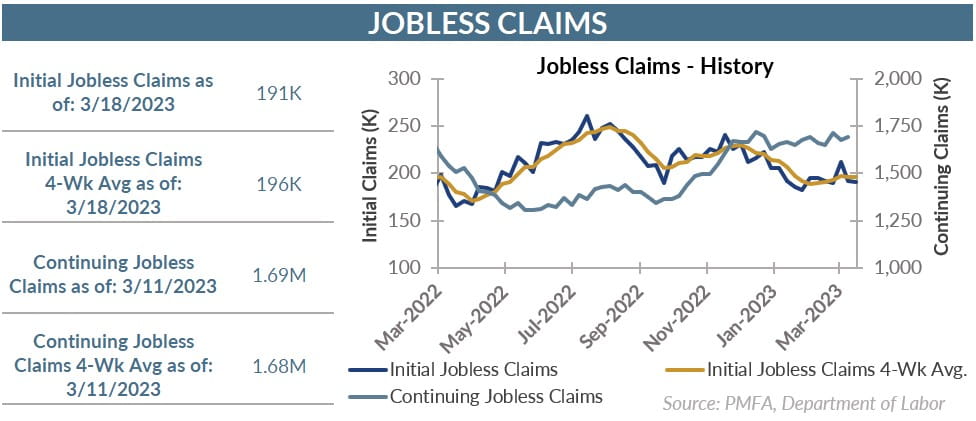
Initial jobless claims came in at 191,000 last week, edging slightly lower than the prior week’s unchanged 192,000 level. The consensus forecast from economists had called for a moderate increase to 198,000. The smoothed four-week moving average was virtually unchanged.
Weekly claims have remained in a relatively narrow band since the beginning of the year, topping 200,000 only twice after staying above that threshold throughout nearly the entire second half of 2022.
Continuing claims declining by over 60,000 last week to 1.94 million — roughly 80,000 above its level a year ago. After a year of aggressive Fed rate increases, the fact that continuing claims are materially unchanged speaks to the underlying strength of the labor market over that period but also suggests that much of the Fed’s tightening to date has yet to take a meaningful bite out of economic activity.
That claims remain so low even after a year of aggressive Fed tightening has to be a source of frustration for policymakers. In its updated economic forecasts yesterday, the Fed reaffirmed their expectation that employment conditions should loosen meaningfully in the coming months, lifting the unemployment rate to 4.5% by the end of this year.
Central to the Fed’s policy focus is inflation that remains well above its 2% target. And although inflation has receded since peaking last summer, the path back to 2% is expected to continue to be frustratingly slow. Moreover, without a meaningful loosening in employment conditions, continued progress will be even more difficult.
There have been some signs of cracks starting to appear in the jobs market, as layoff announcements have picked up in recent months. Still, those layoffs haven’t really moved the needle on the flow of individuals filing for unemployment. Many of the early wave of layoffs emanated from the tech sector, partially reversing its pandemic-era hiring binge. For many of those workers and other higher-income workers who have been terminated, severance packages provided a bridge that negated the need to apply for unemployment benefits. For lower-wage workers who have been laid off, an abundance of job openings has likely made the transition to a new position relatively easy for many.
So where does that leave the Fed? Between a rock and a hard place. If inflation was the only focus for policymakers, a series of additional rate hikes would be on deck in the coming months, as Fed Chair Powell confirmed yesterday. The emergence of cracks in the banking system and the need to bring financial stability to the forefront of the Fed’s attention complicates matters. The unknown at this point is how significant the fallout of recent bank failures and other distress in the system will be. Tighter lending conditions are already apparent. How much the flow of credit could diminish in the coming months remains to be seen, but it could have a much more significant near-term impact on the economy than another quarter-point rate hike. That’s what the Fed will need to continue to weigh before their May policy meeting.
The push and pull between financial market stability and inflation that’s receding more slowly than anyone would prefer will further complicate an already significant challenge for the Fed, increasing the risk of a policy misstep and keeping the door open for a potential recession on the horizon.
The bottom line? Employment conditions remain constructive for workers or those looking for a job, even as the Fed has doubled down on their commitment to knock down inflation and loosen up the labor market. “Don’t fight the Fed” remains good advice in terms of picking a side in this battle, but the recent emergence of cracks in the banking sector could force policymakers to fight the inflation battle with one hand tied behind their back.
Media mention:
Our experts were recently quoted on this topic in the following publication:
Past performance does not guarantee future results. All investments include risk and have the potential for loss as well as gain.
Data sources for peer group comparisons, returns, and standard statistical data are provided by the sources referenced and are based on data obtained from recognized statistical services or other sources believed to be reliable. However, some or all of the information has not been verified prior to the analysis, and we do not make any representations as to its accuracy or completeness. Any analysis nonfactual in nature constitutes only current opinions, which are subject to change. Benchmarks or indices are included for information purposes only to reflect the current market environment; no index is a directly tradable investment. There may be instances when consultant opinions regarding any fundamental or quantitative analysis may not agree.
Plante Moran Financial Advisors (PMFA) publishes this update to convey general information about market conditions and not for the purpose of providing investment advice. Investment in any of the companies or sectors mentioned herein may not be appropriate for you. You should consult a representative from PMFA for investment advice regarding your own situation.




